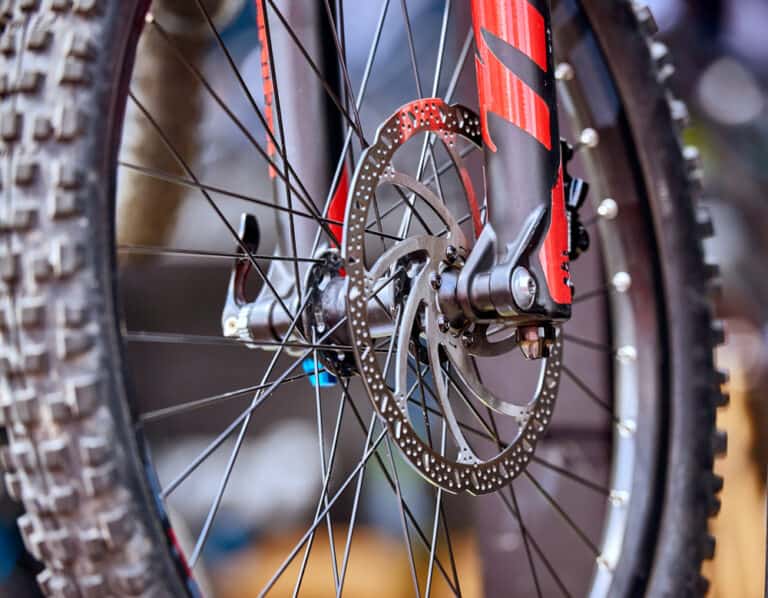Why Are MTB Forks So Expensive?

The suspension forks on a mountain bike are one of its most important components because it directly affects the handling of the bike and the stability of the front end and also has a direct impact (using that word deliberately) on the comfort or discomfort experienced by the rider. So maybe that already begins to explain why mountain bike forks are so expensive – or does it?
For good reason, the forks on a mountain bike are expensive compared to those on a road bike. With the forces exerted on them by drop-offs, rocks, tree roots, and other bone-jarring obstacles that must be negotiated, they are complex pieces of engineering.
Firstly, a brief explanation of what a suspension fork’s function is. Then, by comparing top-level MTB forks with cheaper ones, we’ll give you a better idea of what goes into their design and manufacture, why they cost much more, and why they’re worth every cent.
What Factors Make MTB Forks Expensive?
Mountain bike forks are not all expensive, but the best ones are, for several reasons. The materials used in their construction, the quality of manufacture, and the elements of design, including the diameter of the stanchions, the amount of travel, and the adjustability, are some factors that affect the price as well as the effectiveness of the forks.
The Complex Role Of The MTB Fork
Every bump your front wheel encounters impacts the bike and sends a force upward through the cycle to the cyclist’s hands, wrists and arms.
The suspension fork is designed to absorb some of those impacts, at the same time keeping the wheel in contact with the ground and also keeping it from flexing to the side. In other words, the fork is vital in creating stability and direction while protecting the rider from the full impact of the forces driving up from the front wheel.
The Amount Of Travel Adds To The Cost
By travel, we refer to the ability of the front suspension forks to move up in response to the force exerted on the front wheel without lifting the bike off the road. The movement of the stanchion into the lower portion or leg of the fork reduces the impact on the cyclist.
The cheaper MTB forks will allow travel of about 100 millimeters. This is sufficient to absorb the impact of irregularities in the surface of the trail, such as stones, half-buried roots, and potholes, and is adequate for riders who ride trails and enjoy cross-country riding.
For enduro riders who are negotiating drop-offs, jumps, and steeper up- and down-hills, travel of 150 -180mm is optimal, but you won’t find this on the cheaper forks.
For downhill racing, where the most stress is placed on the front suspension, more significant travel is needed, ideally between 180mm and 200mm. This is found on only the more expensive, technologically advanced forks.
Adjustability Of The Fork Adds To The Cost
Cheaper forks use coil springs to cushion the impact on the front wheel. On some bikes, you can lock out the travel so that the fork effectively becomes rigid, but it’s not adjustable enough to adapt the bike for different riding conditions.
On top-end forks, air springs are adjustable for spring rate (stiffness) by adding or removing air – a quick and simple action that takes a few minutes. So, whether you’re riding cross country or doing a lot of downhill riding, the fork can be adjusted to provide the best possible ride.
Both types of forks have dampers, which act exactly like those on a car, preventing the front end from continuing to bounce after impact with an obstacle. Oil flows from one chamber to another through adjustable ports, so it’s possible on the more expensive forks to control the speed at which the stanchion moves both on compression and rebound. That has a dramatic effect on handling.
Durability And Reliability Adds To The Cost
Several factors affect the strength and durability of a suspension fork, and most of those contribute to the cost of manufacture.
The Best Materials For MTB Forks
The most common materials are steel, aluminum, titanium, magnesium, and carbon fiber. Steel is preferred for its strength and durability, but it’s also the heaviest material. Forged aluminum and magnesium alloys are extensively used, because of their strength and lightweight, while carbon fiber is also becoming ever more popular for specific components.
The Diameter Of The Stanchion In MTB Forks
Another reason MTB forks are expensive is that the stanchions are much larger than in a road bike. They are usually 32mm to 40mm in diameter, as opposed to 20mm in road bikes, in order to provide greater rigidity. The 40mm stanchion, in particular, is recommended for downhill racing, as it has a huge effect on handling and performance. At the same time, the 32mm is adequate for cross-country, where there are fewer obstacles, jumps, and drop-offs.

Are Expensive MTB Forks Worth Their Price?
The cheapest MTB forks are absolutely fine for the weekend rider who owns a relatively inexpensive mountain bike and who enjoys spending time doing a bit of cross-country riding and some less demanding trails.
However, for the competitive rider, the enduro participant, and the downhill racer, the front fork becomes a vital component of his bike. It’s vital that it provides the best possible control, predictable handling and is reliable and able to withstand the forces generated by challenging terrain.
The law of diminishing returns probably applies to the more expensive MTB forks. By that, we mean that the difference between, say, a $300 fork and a $600 fork will be much more significant than the difference between a $600 and a $900 fork. As you reach the top end, a $1500 fork may only have marginal advantages over a $1000 one.
Conclusion
While not all MTB forks are expensive, and there are plenty of examples of good, inexpensive ones, the forks at the top end are the products of a great deal of research, engineering innovation, and the use of the best available materials. For the rider who needs to maximize his performance, the price is well justified and worth every cent.







